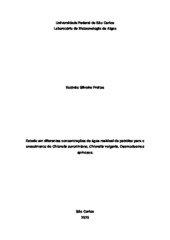| dc.contributor.author | Freitas, Estêvão Silveira | |
| dc.date.accessioned | 2023-04-12T18:44:18Z | |
| dc.date.available | 2023-04-12T18:44:18Z | |
| dc.date.issued | 2023-04-06 | |
| dc.identifier.citation | FREITAS, Estêvão Silveira. Estudo em diferentes concentrações de água residual de petróleo para o crescimento de Chlorella sorokiniana, Chlorella vulgaris, Desmodesmus spinosus e suas combinações. 2023. Trabalho de Conclusão de Curso (Graduação em Biotecnologia) – Universidade Federal de São Carlos, São Carlos, 2023. Disponível em: https://repositorio.ufscar.br/handle/ufscar/17714. | * |
| dc.identifier.uri | https://repositorio.ufscar.br/handle/ufscar/17714 | |
| dc.description.abstract | Petroleum refining involves three steps: separation, conversion and reform. Within all these steps there is the use of water to obtain refined oil. The water that is used is discarded after refinement and when discarded in the environment without treatment, it introduces organic compounds that can be toxic to organisms. Microalgae are photosynthetic organisms and sensitive to various organic and inorganic compounds in the environment in which they are found. Studies on physiological changes serve to diagnose the fate of this wastewater and the impacts on aquatic ecosystems. The objective of this work was to analyze the impacts of wastewater from oil production on the physiology and biochemical composition of different species of microalgae. Three species of microalgae were cultivated in BG-11 medium: Chlorella sorokiniana, Chlorella vulgaris, Desmodesmus spinosus, in addition to their combinations: C. sorokiniana + D. spinosus; C. vulgaris + D. spinosus; C. sorokiniana + D. spinosus + C. vulgaris in different concentrations of wastewater and subsequently determined which concentration showed algae growth. After that, a residual water concentration (5%) was selected for the physiological and biochemical study of the different species of microalgae. The results showed that from 40% residual water there was inhibition of microalgal growth. In 5% of residual water, it was observed that D. spinosus had the growth rate and the photosynthesis affected. The cultures also showed higher dry weight, more carbohydrates than the control, higher chlorophyll a/b ratio. This work contributes to the understanding of the mechanisms by which these microalgae species deal with the conditions generated by wastewater. | eng |
| dc.description.sponsorship | Não recebi financiamento | por |
| dc.language.iso | por | por |
| dc.publisher | Universidade Federal de São Carlos | por |
| dc.rights | Attribution-NonCommercial-NoDerivs 3.0 Brazil | * |
| dc.rights.uri | http://creativecommons.org/licenses/by-nc-nd/3.0/br/ | * |
| dc.subject | Microalgas | por |
| dc.subject | Ecofisiologia | por |
| dc.subject | Biomoléculas | por |
| dc.subject | Microalgae | eng |
| dc.subject | Ecophysiology | eng |
| dc.subject | Biomolecules | eng |
| dc.title | Estudo em diferentes concentrações de água residual de petróleo para o crescimento de Chlorella sorokiniana, Chlorella vulgaris, Desmodesmus spinosus e suas combinações | por |
| dc.title.alternative | Study of different concentrations of petroleum wastewater for the growth of Chlorella sorokiniana, Chlorella vulgaris, Desmodesmus spinosus and their combinations | eng |
| dc.type | TCC | por |
| dc.contributor.advisor1 | Lombardi, Ana Teresa | |
| dc.contributor.advisor1Lattes | http://lattes.cnpq.br/6737850858443813 | por |
| dc.description.resumo | O refinamento do petróleo envolve três etapas, sendo elas de separação, conversão e reforma. Dentro de todas essas etapas há o uso de água, para a obtenção de petróleo refinado. A água que é utilizada é descartada após refinamento e quando descartada no ambiente sem tratamento, introduz compostos orgânicos que podem ser tóxicos aos organismos. As microalgas são organismos fotossintéticos e sensíveis a diversos compostos orgânicos e inorgânicos no meio em que se encontram. Estudos sobre as mudanças fisiológicas servem para um diagnóstico do destino dessa água residual e os impactos nos ecossistemas aquáticos. O objetivo deste trabalho foi analisar os impactos da água residual de produção de petróleo na fisiologia e composição bioquímica de diferentes espécies de microalgas. Foram cultivadas em meio BG-11 três espécies de microalgas: Chlorella sorokiniana, Chlorella vulgaris, Desmodesmus spinosus além de suas combinações: C. sorokiniana + D. spinosus; C. vulgaris + D. spinosus ; C. sorokiniana + D. spinosus + C. vulgaris em diferentes concentrações de água residual e posteriormente determinada qual concentração apresentou crescimento das algas. Após isso foi selecionada uma concentração de água residual (5%) para o estudo fisiológico e bioquímico das diferentes espécies de microalgas. Os resultados mostraram que a partir de 40% água residual houve inibição do crescimento microalgal. Em 5% de água residual, foi observado que D. spinosus teve a taxa de crescimento e a fotossíntese afetadas. As culturas também apresentaram maior peso seco, mais carboidratos que o controle, maior razão de clorofila a/b. Esse trabalho contribui para a compreensão dos mecanismos pelo qual essas espécies de microalgas lidam com as condições geradas pela água residual. | por |
| dc.publisher.initials | UFSCar | por |
| dc.subject.cnpq | CIENCIAS BIOLOGICAS | por |
| dc.publisher.address | Câmpus São Carlos | por |
| dc.contributor.authorlattes | http://lattes.cnpq.br/5130537569721565 | por |
| dc.publisher.course | Biotecnologia - Biotec | por |

